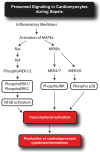Molecular events in the cardiomyopathy of sepsis
- PMID: 18256728
- PMCID: PMC2227904
- DOI: 10.2119/2007-00130.Flierl
Molecular events in the cardiomyopathy of sepsis
Abstract
Septic cardiomyopathy is a well-described complication of severe sepsis and septic shock. However, the interplay of its underlying mechanisms remains enigmatic. Consequently, we constantly add to our pathophysiological understanding of septic cardiomyopathy. Various cardiosuppressive mediators have been discovered, as have multiple molecular mechanisms (alterations of myocardial calcium homeostasis, mitochondrial dysfunction, and myocardial apoptosis) that may be involved in myocardial dysfunction during sepsis. Finally, the detrimental roles of nitric oxide and peroxynitrite have been unraveled. Here, we describe our present understanding of systemic, supracellular, and cellular molecular mechanisms involved in sepsis-induced myocardial suppression.
Figures




References
Publication types
MeSH terms
Substances
Grants and funding
LinkOut - more resources
Full Text Sources
Medical

